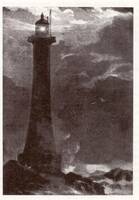- England
- Scotland
- France
- Holland
- Germany
- Italy
- Spain
- Portugal
- USA
- China
- Japan
- India
- Iran
- Advice
- Gardens
- England
- Scotland
- France
- Holland
- Germany
- Italy
- Spain
- Portugal
- USA
- China
- Japan
- India
- Iran
- Advice
- Garden Tours
Book: Landscape Planning and Environmental Impact Design: from EIA to EID
Chapter: Chapter 2 Landscape plans for public goods
Landscape quality is a public good. The distinction between private and public goods is that the former can be purchased, owned and consumed. Houses, apples and seats at the opera are examples of private goods. The characteristics of public goods are non-depletability and non-charagability. A lighthouse is the traditional shining example [Fig 2.1 A lighthouse distributes a public good which costs money, which is not depleted by over-use and for which no charge is made. Lighthouse plans ]. However many people benefit, the source of light and safety is not depleted. A lighthouse has to be paid for but it is impractical to levy a charge on the individual sailors who are warned away from dangerous rocks in tempestuous seas. In cities, the following points about public goods should be kept in mind: -one cannot charge for fresh air, beautiful views, clean rain, fine townscape, access to public space, listening to the birds, or the presence of a hedgehog population, -we want public goods but cannot, as individuals, decide to purchase more of them, -the fact that I benefit from a public good (eg clean rain) does not decrease your opportunity to benefit from the same good, -a large stock of public goods makes some cities more desirable than others as places to live, work and visit, -if public goods are not protected, they tend to decay, -if new public goods are to be created, plans must be agreed and implemented. The distinction between public and private goods is useful in clarifying the objectives of planning, but it is not hard or fast. Roadspace is usually made available as a public good, but it can be subject to tolls. Available roadspace can also be depleted, by abrasion or congestion. To protect and enhance public goods, communities need plans. This chapter will review some of types of landscape plan which are required. They can be thought of as lighthouse plans, because they show directions for movement. Some public goods will only benefit some sections of "the public" and may harm the interests of other sections. Therefore planning must be subject to plural control by democratic bodies, community groups and individuals.
